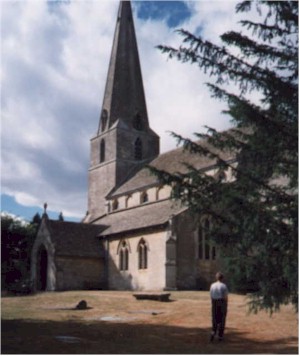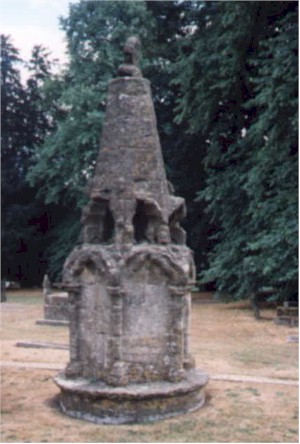Bisley Notes
Bisley is situated in the County of Gloucestershire, England, on the Cotswolds plateau, approximately four miles east of Stroud.
The decline of the wool industry in the nineteenth century caused great hardship throughout the Cotswolds. In an attempt to ease the poverty in Bisley the parish persuaded 68 persons to emigrate. They were transported by two wagons and a cart to Bristol, and on 31 August 1837 they joined a steam packet en route to the New World. Bisley paid the costs of £191 3s 1d, including the provision of Bibles and Prayer Books. The money was raised by public subscription and by borrowing on the security of the rates.
The Parish Registers.
Records begin in 1547, the first volume covering the period up to 1700. In the
section for 1589 is the note "Here are many christenings through negligence
omitted".
There are no entries for the period between 1628-1631, and only one in 1632, the
burial of the Vicar's wife, Katherine Sedgwick. Entries are sparse, or missing, in other
years:-
1627 no marriages. 1635 two marriages. 1644 "the christenings of the month of
May was lost by reason of the troubles of the time". 1663 "by a mischance there
were many names lost of this year, of baptisms. Many of the weddings were lost of this
year". 1673 "Many christenings lost this year, I know not how".
Parish Registers covering the period from 1547-1967 are deposited with the Gloucestershire Record Office. Entries between 1608 and 1812 are included in the IGI.
All Saints Church, Bisley.
 It is mentioned in the Doomsday book that there were two
priests in the manor of Bisley, and a few remains have been unearthed, indicating the
existence of a church in the Saxon era. In Hugh de Bisley's will of 1415 is mention of the
church of All Saints of Bysseley.
It is mentioned in the Doomsday book that there were two
priests in the manor of Bisley, and a few remains have been unearthed, indicating the
existence of a church in the Saxon era. In Hugh de Bisley's will of 1415 is mention of the
church of All Saints of Bysseley.
There are Roman or Saxon stones built into the outside of the chapel at the east end.
The canopy attached to the south chancel wall dates from the thirteenth century.
The chancel, north aisle, and probably the lower stages of the tower were built in the reign of Edward II. In Richard II reign the rest of the tower was built, together with other work.
The bowl of the font, originally made in the Norman period, was found in 1850 on the top of the well cover. In 1862, during extensive restoration of the church, it was restored to its proper place in the church. A pedestal for the font was carved by the Rev. T. Meyrick of Corpus Christi College, Oxford.
The Well - Cover
 In the south west of the church is a well-cover originating from the
thirteenth century. Sometimes called the Bone House or the Churchyard Cross, it covers a
disused well.
In the south west of the church is a well-cover originating from the
thirteenth century. Sometimes called the Bone House or the Churchyard Cross, it covers a
disused well.
Tradition relates that on a dark night the priest was summoned to a dying parishioner, but he never appeared. The villagers carried out search and found the body of the priest in the well, into which he had fallen in the dark. The well-cover was built to avoid a repeat of the accident.
Abel Watner's "History of Gloucestershire", written in 1714, provides an alternative tale :-
The church of Bisley was out of repair, and the officers of the parish set some men to mend what was amiss; amongst those labourers was one whose name was Pearse, who, with the rest at dinner time, came into the churchyard, where there was a winch-well, and where they usually sat around whilst they did eat their victuals. Now it is fortuned, that as they were just waiting for the striking of the clock to go to work, that as the clock struck, Pearse replyed, "There's one", which words were no sooner spoken, but he fell backwards into the well and was drowned. Whereupon the churchyard was excommunicated, and the parish did bury their dead at Bibury, which is eighteen miles a sunder.
The village lock - up.
In common with many other villages, Bisley had a village lock-up, or blind house, used to hold drunks and vagabonds overnight. Unusually however it still exists, having been restored in 1998. The building - a two cell affair built in 1824, is situated at the top of George Street, facing a wall of the church. The front, of cotswold stone, has a steel grilled door to each cell, with an ogee roof gable topped with a ball finial.
Seven Springs Well.
A public water supply is situated at Seven Springs in Well road. The original five spouts are supplied from a spring under the churchyard; two additional spouts, fed from a spring in Inakers field, were installed in 1863 when the present well head was fitted. The well blessing ceremony, held annually on Ascension Day, dates from this time, and was started by the Rev. Thomas Keble. The wells are blessed by the Vicar of Bisley and children and parishioners decorate the well with flowers.
The photographs were taken by John Hyde in 1995.
